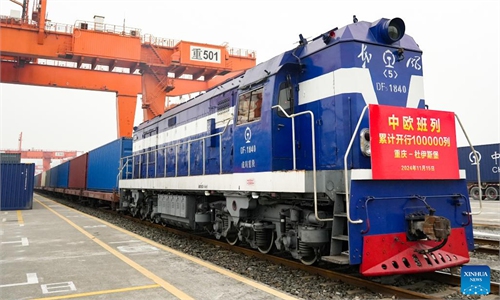By Li Xinping, People’s Daily
At 10:20 am on Nov. 15, the 100,000th China-Europe freight train, marked as X8083, departed from Tuanjiecun Station in southwest China’s Chongqing municipality, and headed for Duisburg, Germany. It marked another milestone after the 90,000th was recorded in May.
Statistics show that the time required to dispatch 10,000 trains has been reduced from 90 months in the early days of operation to just 6 months today.
More than 1,000 years ago, the steady rhythm of camel caravans brought prosperity to the ancient Silk Road. Today, the roaring China-Europe freight trains have become the modern embodiment of cooperation and mutual benefit.
Over the past decade, the China-Europe freight train network has grown increasingly dense. In China, the network connects 125 cities with 93 regular train routes with a speed of 120 kilometers per hour. Internationally, it spans 25 European countries and 227 cities, as well as more than 100 cities in 11 Asian countries.
These “steel camel caravans” traverse continents, fostering trade connectivity and driving economic growth.
Operating weekly with seven outbound and six return trips, the trains maintain a balanced two-way flow. The 100,000 trains have transported more than 11 million TEUs (twenty-foot equivalent units) of goods across Eurasia, with a total trade value exceeding $420 billion and a catalog of over 53 major categories encompassing 50,000 distinct products.
German automobiles, Polish apples, Dutch cheese, Kazakh flour – more and more countries along the routes are benefiting from access to the Chinese market. For instance, in 2023, apple trade between Poland and China increased 23.2 percent year on year.
At the same time, the China-Europe freight trains have enabled faster and more cost-effective delivery of Chinese-made goods like electronics, home appliances, and new energy vehicles to Central Asia and Europe, propelling Chinese manufacturing to global markets.
The China-Europe freight trains exemplify the appeal of openness and connectivity.
Many Chinese inland cities far from coastlines or borders have become new hubs of international trade thanks to the trains. For example, Chongqing has seen its export-oriented industries grow by an average of 30 percent annually due to the freight network. Similarly, Chengdu and Zhengzhou, capital cities of Sichuan province and Henan province, respectively, have transformed into key centers for import-export trade and modern international logistics.
Internationally, the trains have spurred the development of new logistics hubs, industrial zones, and trade centers, creating significant job opportunities. At Germany’s Duisburg Port, the operation of China-Europe freight trains has attracted over 100 logistics companies, generating more than 20,000 jobs. In Poland, theMałaszewicze rail terminal has experienced exponential business growth thanks to the trains, which greatly boosted the local economy and social development.
Since its inception, the China-Europe freight train network has maintained safe, stable, and efficient operations, establishing a new framework for transcontinental transportation. It has created a robust platform for trade cooperation along its routes, ensured the stability of global industrial and supply chains, and injected fresh momentum into the world economy.
Connecting hundreds of cities and navigating diverse railway regulations, the China-Europe freight trains are a result of China’s commitment to high-level institutional opening up.
China has established a domestic China-Europe Transport Coordination Committee, and co-established a joint work team with six other countries to deepen cooperation on China-Europe freight rail services, in an attempt to facilitate “soft connectivity” of international railway rules.
Additionally, the collaboration between Chinese customs and railway authorities has led to the development of a “95306 digital port system,” significantly enhancing customs efficiency and streamlining clearance processes.
Through continuous expansion of institutional opening up in areas such as rules, regulations, management, and standards, the China-Europe freight trains have elevated Eurasian connectivity to new heights.
From launching daily services across the Caspian Sea to increasing the number of scheduled trains, and to fostering deeper collaboration between the China-Europe freight trains and the China-Laos Railway, the network is constantly evolving. It is propelling high-level opening-up to deeper and more practical levels.
As the trains forge ahead, they accelerate the pace of mutual benefit and shared prosperity, writing a new chapter in global trade and cooperation.













